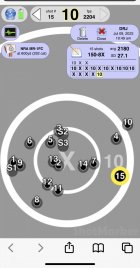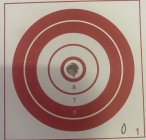Yes, it is. Great weekend of shooting. A .22 benchrest Saturday and a 600 Fclass Sunday, both went well. Both got me thinking about something they have in common.
Score ring shooting has a quirk. The center of our shot can clearly miss the ring, but we get credit if the edge of our bullet touches the ring. I call it a quirk because a bullet that only tangentially touches a target doesn’t really do anything, but anyway. Years ago we had gauges made up for ranges in every conceivable caliber to help iron out tricks played on the eyes.
Yesterday, I shot a .284. The system was open to caliber changes, which I requested shooters make after saving, before we started. On my last match, I was shown a 150-8X. But, the default was .308. Although no one would have said anything, I re-ran it suspecting a 149-8, and indeed that’s what it was.
But here’s what’s new, that I have not seen analyzed, before.
Just how precise is the ShotMarker’s center to edge placement? Extremely, relative to our caliber increments, it turns out.
So by the eye on a phone screen I surmised that I’d lose on the difference between a 7mm and a 7.62 mm bullet. Remember, it’s actually half the difference because there is as much bullet on the irrelevant side of the center.
It turns out that if I shot a .292 caliber on up, it’s a 150.

If I shoot a 291 caliber, on down, it’s a 149.

Walking that in showed a ShotMarker is capable of seeing a gulf of difference between a 30 cal and 7mm. We are talking on the order of magnitude of 24 one thou gradations between the two, (half of that which impacts score) and then drawing a circle that is capable of splitting those gradations in half. A 7mm only “reaches” out from its center 92.2% as far as a .30 does, and a 6, only 78.9%.
.22 BR at 50 yards fits in oddly to the discussion. We want this, but it doesn’t always happen.

On a “P” for .22 pinned and magnified target, we get just as much credit for this, which clearly is not “as good” a shot.

This shot below is almost identical to the pinned shot. The pinned shot and it both come much closer to each other than they do to the first picture. It however is properly a -1.

It’s tempting to round to 30 for all assuming it can’t tell a difference but, looks like it can, many times over. Preserving these small differences does make .22 BR a blast to shoot. If a guy used a 30 cal, the difference in score would be tremendous.
An open mic ShotMarker might indeed not put the center exactly where the paper hole would say it is, relative to other shots and the target center, but it’s thought to put the center of each shape, speed and size bullet in the same starting place as each other, our part being the manual caliber selection, and it sure can draw an amazingly precise circle that is no doubt finer than the pixels on any screen.
Score ring shooting has a quirk. The center of our shot can clearly miss the ring, but we get credit if the edge of our bullet touches the ring. I call it a quirk because a bullet that only tangentially touches a target doesn’t really do anything, but anyway. Years ago we had gauges made up for ranges in every conceivable caliber to help iron out tricks played on the eyes.
Yesterday, I shot a .284. The system was open to caliber changes, which I requested shooters make after saving, before we started. On my last match, I was shown a 150-8X. But, the default was .308. Although no one would have said anything, I re-ran it suspecting a 149-8, and indeed that’s what it was.
But here’s what’s new, that I have not seen analyzed, before.
Just how precise is the ShotMarker’s center to edge placement? Extremely, relative to our caliber increments, it turns out.
So by the eye on a phone screen I surmised that I’d lose on the difference between a 7mm and a 7.62 mm bullet. Remember, it’s actually half the difference because there is as much bullet on the irrelevant side of the center.
It turns out that if I shot a .292 caliber on up, it’s a 150.

If I shoot a 291 caliber, on down, it’s a 149.

Walking that in showed a ShotMarker is capable of seeing a gulf of difference between a 30 cal and 7mm. We are talking on the order of magnitude of 24 one thou gradations between the two, (half of that which impacts score) and then drawing a circle that is capable of splitting those gradations in half. A 7mm only “reaches” out from its center 92.2% as far as a .30 does, and a 6, only 78.9%.
.22 BR at 50 yards fits in oddly to the discussion. We want this, but it doesn’t always happen.

On a “P” for .22 pinned and magnified target, we get just as much credit for this, which clearly is not “as good” a shot.

This shot below is almost identical to the pinned shot. The pinned shot and it both come much closer to each other than they do to the first picture. It however is properly a -1.

It’s tempting to round to 30 for all assuming it can’t tell a difference but, looks like it can, many times over. Preserving these small differences does make .22 BR a blast to shoot. If a guy used a 30 cal, the difference in score would be tremendous.
An open mic ShotMarker might indeed not put the center exactly where the paper hole would say it is, relative to other shots and the target center, but it’s thought to put the center of each shape, speed and size bullet in the same starting place as each other, our part being the manual caliber selection, and it sure can draw an amazingly precise circle that is no doubt finer than the pixels on any screen.
Attachments
Last edited:











